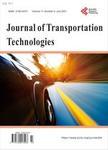Controlling Congestion in Al-Seeb Highway Using Ramp Metering (Case Study)
Controlling Congestion in Al-Seeb Highway Using Ramp Metering (Case Study)作者机构:College of Engineering National University Muscat Oman
出 版 物:《Journal of Transportation Technologies》 (交通科技期刊(英文))
年 卷 期:2024年第14卷第3期
页 面:308-335页
学科分类:08[工学] 082303[工学-交通运输规划与管理] 082302[工学-交通信息工程及控制] 0823[工学-交通运输工程]
主 题:On-Ramp Merge Ramp-Metering Vissim Simulation
摘 要:This paper represents a case study of traffic congestion within a section on Al Seeb Street highway due to the on-ramp merging of vehicles that causes a bottleneck in the mainline road. It studies the efficiency of installing ramp metering within a ramp within the selected study zone. This is done by simulating the collected data using Vissim software by drawing three one-hour-long scenarios;the first scenario reflects the data collected for 30 minutes duration and is used as a base scenario to draw the other two scenarios, which are reflected as factored-up scenarios to create a situation observed in the early morning in the study zone at 6:00-7:00 in which slowing down of speeds exist, and breakdown is raised in working days. The two factoring-up scenarios were as follows: one without ramp metering and the other without ramp metering. Each scenario was calibrated and run five times with random seeds, and then the average was considered. The simulation examines the ability of RM to smooth traffic in mainline and reduce queuing on on-ramp roads within the selected study zone by comparing the performance of the network for the scenarios and comparing them in terms of the overall delays, number of stops and the average speeds for the vehicles within the mainline. The results showed a good performance reflected by the scenario with ramp metering with a reduction of the overall delay, a decrease in stops number and an increase of the average speed were achieved. For the base scenario, a visualization (video extracted from Vissim software) was extracted, showing no need to install RM with an associated table showing a number of stops equal to zero with an average speed of 102.74 km/h and a total delay of 6045 seconds. For the second scenario with no RM, a visualization was extracted showing a slowing down of speeds for vehicles within the mainline while vehicles merging from the on-ramp and need to be controlled with a table showing a number of stops equal to 16 and an a



